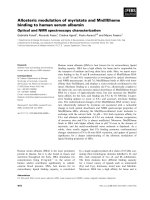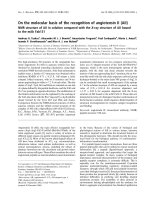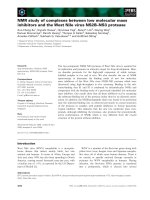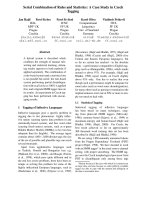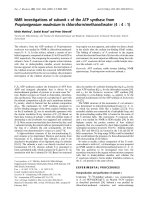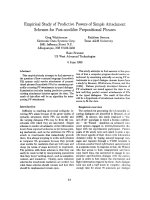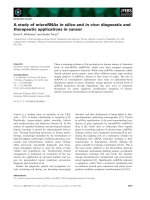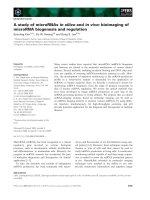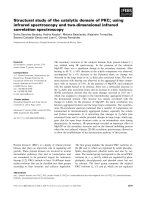Báo cáo khoa học: NMR study of cellulose and wheat straw degradation by Ruminococcus albus 20 pdf
Bạn đang xem bản rút gọn của tài liệu. Xem và tải ngay bản đầy đủ của tài liệu tại đây (494.03 KB, 9 trang )
NMR study of cellulose and wheat straw degradation by
Ruminococcus albus 20
Maria Matulova
1,2
,Re
´
gis Nouaille
2,3
, Peter Capek
1
, Michel Pe
´
an
4,5,6
, Anne-Marie Delort
2
and
Evelyne Forano
3
1 Institute of Chemistry, Slovak Academy of Sciences, Centre for Glycomics, Bratislava, Slovak Republic
2 Laboratoire de Synthe
`
se et Etude de Syste
`
mes a
`
Inte
´
re
ˆ
t Biologique, UMR 6504, Universite
´
Blaise Pascal, CNRS, Aubie
`
re, France
3 INRA, UR 454 Unite
´
de Microbiologie, Centre de Recherches de Clermont-Ferrand-Theix, Saint-Gene
`
s-Champanelle, France
4 CEA, DSV, IBEB, Groupe Recherches Applique
´
s Phytotechnologie, Saint-Paul-lez-Durance, France
5 CNRS, UMR Biologie Vegetale & Microbiolgie Environnementale, Saint-Paul-lez-Durance, France
6 Aix-Marseille Universite
´
, Saint-Paul-lez-Durance, France
Ruminococcus albus is a Gram-positive rumen bacte-
rium widely recognized for its high cellulolytic activity.
It is the predominant cellulolytic bacterial species
found in the rumen of cows [1], but is outnumbered by
the other rumen cellulolytic species, R. flavefaciens and
Fibrobacter succinogenes, in the rumen of sheep [2].
In vitro studies have shown that R. albus becomes pre-
dominant over the other two fibrolytic species in
co-cultures on cellulose [3,4]. Data have also shown
the negative interaction of R. albus and F. succinogenes
on lucerne cell-wall polysaccharide degradation, as well
as the complementary effect of R. albus and R. flav-
efaciens in lucerne hemicellulose degradation [5]. The
interactions of cellulolytic species in fibre degradation
therefore appear to be very complex, depending on
several factors. An understanding of how the cellu-
lolytic system of each species operates on natural
substrates should aid in the determination of these
complex interactions. The fibrolytic system of R. albus
is composed of many different cellulases, xylanases
Keywords
cellulose; NMR; rumen; Ruminococcus
albus; wheat straw
Correspondence
E. Forano, INRA, Unite
´
de Microbiologie,
Centre de Recherches de Clermont-Ferrand-
Theix, 63122 Saint-Gene
`
s-Champanelle,
France
Fax: +33 473 62 45 81
Tel: +33 473 62 42 48
E-mail:
(Received 25 February 2008, revised 7 May
2008, accepted 7 May 2008)
doi:10.1111/j.1742-4658.2008.06497.x
Cellulose and wheat straw degradation by Ruminococcus albus was moni-
tored using NMR spectroscopy. In situ solid-state
13
C-cross-polarization
magic angle spinning NMR was used to monitor the modification of the
composition and structure of cellulose and
13
C-enriched wheat straw during
the growth of the bacterium on these substrates. In cellulose, amorphous
regions were not preferentially degraded relative to crystalline areas by
R. albus. Cellulose and hemicelluloses were also degraded at the same rate
in wheat straw. Liquid state two-dimensional NMR experiments were used
to analyse in detail the sugars released in the culture medium, and the inte-
gration of NMR signals enabled their quantification at various times of
culture. The results showed glucose and cellodextrin accumulation in the
medium of cellulose cultures; the cellodextrins were mainly cellotriose and
accumulated to up to 2 mm after 4 days. In the wheat straw cultures,
xylose was the main soluble sugar detected (1.4 mm); arabinose and glucose
were also found, together with some oligosaccharides liberated from hemi-
cellulose hydrolysis, but to a much lesser extent. No cellodextrins were
detected. The results indicate that this strain of R. albus is unable to use
glucose, xylose and arabinose for growth, but utilizes efficiently xylooligo-
saccharides. R. albus 20 appears to be less efficient than Fibrobacter succin-
ogenes S85 for the degradation of wheat straw.
Abbreviations
13
C-CP MAS,
13
C-cross-polarization magic angle spinning; HSQC, heteronuclear single quantum coherence; PE, polyethylene; PP,
polypropylene; TSP-d
4
, sodium 3-(trimethylsilyl) propionate.
FEBS Journal 275 (2008) 3503–3511 ª 2008 The Authors Journal compilation ª 2008 FEBS 3503
and esterases [6]. Although many of these enzymes
have been characterized, little is known about their
concurrent mode of action on solid substrates.
In the present work, the degradation and metabolism
of cellulose and wheat straw by R. albus 20 cells grow-
ing on these substrates were studied using NMR.
A kinetic analysis of the polysaccharides degraded and
of the sugars solubilized should aid in the understand-
ing of the action of the cellulolytic system and in the
evaluation of its efficiency in the degradation process.
We used a combined approach previously developed to
examine the action of the F. succinogenes S85 fibrolytic
system on lignocellulosic fibres [7]. In situ solid-state
13
C-cross-polarization magic angle spinning (
13
C-CP
MAS) NMR was used to monitor the degradation of
cellulose and
13
C-enriched wheat straw. The advanta-
ges of this method are that: (1) it is nondestructive for
the materials being investigated; (2) it resolves as many
separate components as possible; and (3) it is quanti-
tative for these components and is straightforward to
implement (although a long acquisition time may be
necessary). In parallel, liquid state two-dimensional
NMR experiments were used to analyse in detail the
various sugars released. We also compared the action
of R. albus and F. succinogenes on the solid fibrous
substrates.
Results
Growth of R. albus on cellulose and wheat straw
R. albus 20 was grown for up to 4 days with 100 mg
of cellulose (Sigmacell 20) or
13
C-labelled or unlabelled
wheat straw. Growth was monitored by the quantifica-
tion of fermentation products performed by both
1
H
NMR (Figs 1 and 2) and enzymatic methods. Figure 1
shows an example of the spectra obtained before and
after 4 days of culture of R. albus 20 on wheat straw.
The metabolites acetate (a), lactate (l) and formate (f)
were detected and quantified after subtracting the peak
areas obtained at t = 0 (caused by acids present in the
culture medium). Ethanol was quantified on the spec-
tra registered without lyophilization of the extracellular
medium. Figure 2 shows that the concentration of
these metabolites reached a maximum between 24 and
48 h, and then remained fairly constant. The metabo-
lites were not produced at the same concentration
when the cells were grown on cellulose (Fig. 2A) and
straw (Fig. 2B), except for lactate. Ethanol and for-
mate concentrations were twofold lower on straw, and
acetate was also produced at a slightly lower concen-
tration on this substrate. The metabolite concentra-
tions measured in cellulose cultures were similar to
a
a* a*
p + b
b
b
p
l
l
w
f
T0
T
=
96 h
t
T0
T
=
96 h
2.2 2.0 1.8 1.6 1.4 1.2 1.0 p.p.m.
8.0 7.5 7.0 6.5 6.0 5.5 5.0 4.5 4.0 3.5 3.0 2.5 2.0 1.01.5 0.5 p.p.m
Fig. 1.
1
H NMR spectra registered before (T0) and after (T =96h)
4 days of growth of R. albus 20 on wheat straw. a, acetate; a*,
acetate satellites J
1H–13C
; b, butyrate; f, formate; l, lactate; p, propi-
onate; t, TSP-d
4
; w, HOD.
0
2
4
6
8
10
12
14
A
B
0 8 16 24 32 40 48 56 64 72 80 88 96
0
2
4
6
8
10
12
0 8 16 24 32 40 48 56 64 72 80 88 96
Fig. 2. Metabolites produced during the growth of R. albus 20 on
cellulose and wheat straw. R. albus 20 cells were grown at 38 °C
on 10 mL of mineral medium with 100 mg of cellulose (A) or wheat
straw (B). Time dependence of acetate (
), formate ( ), lactate ( )
and ethanol (d) concentrations, quantified by
1
H NMR. Values are
the means ± standard deviation of two experiments.
Degradation of wheat straw by R. albus M. Matulova et al.
3504 FEBS Journal 275 (2008) 3503–3511 ª 2008 The Authors Journal compilation ª 2008 FEBS
those found when cellobiose was used as a substrate
(not shown). No growth of R. albus 20 was obtained
when xylose, arabinose or glucose (3 g ÆL
)1
) was used
as a substrate, whereas cells grew well on cellobiose
and xylans (not shown).
Monitoring of cellulose and wheat straw
degradation by analysis of the solid residue
R. albus 20 cells, grown in the presence of Sigmacell 20
or
13
C-labelled wheat straw, were harvested after 8, 16,
24, 48, 56, 72 and 96 h of growth. A similar experi-
ment was carried out in parallel with F. succinogenes
S85 for comparison. The pellet containing bacteria and
the solid fibres, obtained after centrifugation, was
freeze-dried and analysed further by
13
C-CP MAS
NMR. The quantification of the
13
C signals of the
crystalline and amorphous zones obtained on pellets of
both cellulose and
13
C-labelled wheat straw was per-
formed as described previously [7]. The CH
2
signals of
polypropylene (PP at d 43.8 p.p.m.) and polyethylene
(PE at d 32.8 p.p.m.) were used as internal reference
signals. The spectra obtained showed that the signals
of the crystalline and amorphous zones of cellulose, as
well as the signals caused by hemicellulose, decreased
at the same rate. This suggests that these substrates
are degraded by R. albus 20 and F. succinogenes S85 at
the same rate (Fig. 3). This result is similar to that pre-
viously observed on wheat straw with F. succinogenes
S85 [7]. However, the comparison of the degree of deg-
radation of both substrates after the same cultivation
time showed a higher efficiency of F. succinogenes S85
(Fig. 3).
Monitoring of cellulose and wheat straw
degradation by analysis of the culture medium
The degradation of cellulose and wheat straw by
R. albus 20 was monitored by analysis of the compo-
nents solubilized in samples of culture medium (taken
at different time intervals after discarding the cell
and straw pellet) by
1
H–
1
H COSY and
1
H–
13
C hetero-
nuclear single quantum coherence (HSQC) NMR
experiments. Table 1 shows the chemical shifts of the
metabolites identified or searched for in the culture
medium of R. albus 20 grown with cellulose and wheat
straw.
Cellulose degradation
Figure 4A1 shows the anomeric region of the COSY
spectrum and Fig. 4A2 shows the anomeric region of
the heterocorrelated HSQC spectrum of the sample
obtained after 4 days of culture of R. albus 20 with Sig-
macell 20 cellulose. The cross-peaks of the nonreducing
glucose unit CD
n
of cellobiose (bGlc(1 fi 4)Glc) and its
reducing end glucose units CDa and CDb, those of free
aGlc and bGlc and the signal of an unknown metabolite
X2 are found in Fig. 4A1. In the HSQC spectrum
(Fig. 4A2), a characteristic chemical shift caused by the
H1 ⁄ C1 cross-peak signal at d 5.46 ⁄ 94.52 suggests the
presence of a derivative of Glc1P (marked *). However,
A
Sigmacell 20
RA 20
FS 85
cr
am
PE
St
C1 C4
C6
C2-C5
B
Wheat straw
RA 20
FS 85
cr
am
PP
St
C1 C4
C6 OMe OAc
C2-C5
100908070605040p.p.m.
100110 90807060504030p.p.m.
Fig. 3.
13
C-CP MAS NMR spectra of cellulose (A) and wheat straw
(B) before and after the growth of R. albus 20 and F. succinogenes
S85. St, Sigmacell 20 cellulose or wheat straw before bacterial
inoculation (full black line); RA 20, after 4 days of R. albus 20
growth (green broken line); FS 85, after 4 days of F. succinoge-
nes S85 growth (full red line). The experiments were performed at
least in duplicate; representative spectra are shown here. am, sig-
nal of amorphous zone; C1–C6, assignment of carbon signals of
cellulose (A) or cellulose and hemicellulose (B); cr, signal of crystal-
line zone; OAc, O-acetyl groups; OMe, O-methyl groups; PE, poly-
ethylene standard; PP, polypropylene standard.
M. Matulova et al. Degradation of wheat straw by R. albus
FEBS Journal 275 (2008) 3503–3511 ª 2008 The Authors Journal compilation ª 2008 FEBS 3505
its broad signal at d 5.46 in the
1
H NMR spectrum did
not give any cross-peak in the COSY spectrum because
of the very low
3
J
H1,H2
and
3
J
H1,31P
coupling constants.
An aglycon part of the molecule may be the reason for
this coupling constant change.
Figure 5A shows the concentration changes of the
metabolites released during the growth of R. albus 20
with Sigmacell 20 cellulose. The NMR signal intensi-
ties of the identified metabolites were quantified in the
1
H NMR spectra at different times relative to those of
the internal standard sodium 3-(trimethylsilyl) propio-
nate (TSP-d
4
). Glucose and cellodextrins accumulated
with time in the culture medium. Glc1 P was produced
during the first 2 days, and then remained at a con-
stant concentration. The concentration of X2 was
rather low, and increased slowly with time. It should
be noted that X2 was already present at time zero
(0.16 mm), probably because of its presence in the bac-
terial culture used for inoculation. TLC analysis of the
culture medium revealed that, in addition to a small
quantity of cellobiose, the main component of cello-
dextrins is cellotriose (not shown).
Wheat straw degradation
Spots on the very complex in situ two-dimensional
NMR spectra were identified by a comparative analysis
with standards and literature data on the basis of their
characteristic H1, H2 and C1 chemical shifts (Table 1).
Figure 4B1 shows part of a COSY spectrum of the
culture medium obtained after 4 days of culture of
R. albus 20 on wheat straw. The cross-peaks of free
glucose, arabinose, X2 and xylose were detected. Sig-
nals of other metabolites could not be identified
because of the low concentration and splitting of the
signals by the
1
J
1H,13C
coupling constant. However,
they appeared in the HSQC spectrum.
The HSQC spectrum of the incubation medium
obtained after 4 days of culture is shown in Fig. 4B2.
The signals of free xylose, glucose and arabinose were
identified. The signal intensity of X2 indicated that just
traces were present. Characteristic signals of a-arabin-
ofuranose (Araf
Xyl
), which may be linked to both O2
and O3 or separately to O2 or O3 of xylose residues,
suggested the presence of arabinoxylan oligosaccha-
rides in the culture medium (Table 1, Fig. 4B2). The
presence of glucuronoxylan oligosaccharides with
substitution of the xylose units at O2 by 4-O-methyl
glucuronic acid was suggested by the presence of
GlcA
-Xyl
and Xyl
-GlcA
signals (Table 1, Fig. 4B2).
Figure 5B shows the concentration changes of the
metabolites released during the growth of R. albus 20
with wheat straw, and quantified as described above.
Free xylose accumulated clearly in the culture medium
with time (up to 1.4 mm after 4 days). Free glucose
and arabinose also accumulated, but at a much lower
level. The intensity of the cross-peak caused by the
internal xylose units of xylooligosaccharide chains at d
Table 1. Chemical shifts of the metabolites present or searched for in the culture medium of R. albus 20. Chemical shifts were determined
in samples at 27 °C after pH correction to pH 7.4, or were from [7]. The H1 signal of 1-O-methyl-b-
D-xylopyranose was taken as standard.
aAraf
Xyl
, a-arabinofuranose linked to O2, O3 or O2, O3 of xylose unit; Arap, arabinopyranose; CB, cellobiose; CD, cellodextrin; aGalf
Man
, a-
galactofuranose in galactomannan or arabinogalactan; Glc, glucose; GlcA, glucuronic acid; GlcA
Xyl
, a-glucuronic acid linked to O2 of xylose;
Glc6P, glucose 6-phosphate; int, internal; Malt, maltose; Malt-1P, maltose phosphate; MD, maltodextrin; nr, nonreducing end; 1-O-Me-Xylp,
1-O-methyl-b-
D-xylopyranose used as standard; nd, not determined; red, reducing end; term, terminal; X2, unidentified derivative of glucose;
Xyl, xylose; Xyl
GlcA
, xylose unit substituted at O2 by a-glucuronic acid.
Residue
Chemical shift d (p.p.m.)
Residue
Chemical shift d (p.p.m.)
H1 C1 H2 H1 C1 H2
aGlc 5.24 92.93 3.54 CD
term
4.51 102.35 3.32
bGlc 4.65 96.75 3.24 aArap 4.53 97.60 3.52
aGlc6P 5.24 93.07 3.58 bArap 5.25 93.41 3.82
bGlc6P 4.65 96.92 3.28 aXyl 5.20 93.32 3.53
Glc1P 5.46 94.16 3.52 bXyl 4.59 97.64 3.23
Malt-1P
nr
5.43 100.41 3.58 Xyl
int
4.47 102.6 3.27
Malt-1P
red
5.46 94.28 3.52 bXyl
red
4.60 97.24 3.26
MD
term
5.41 100.59 3.59 aXyl
red
5.20 92.79 3.56
MD
int
5.41 100.41–100.37 3.63 Xyl
GlcA
4.63 102.4 3.43
aMD
red
5.24 92.74 3.58 GlcA
Xyl
5.32 98.30 3.58
bMD
red
4.66 96.60 3.28 aAraf
Xyl
5.3–5.1 110–107 4.1–4.0
CB
nr
4.52 103.31 3.32 aGalf
Man
5.10 108.2 nd
aCB
red
5.23 92.68 3.59 1-OMe-Xylp 4.33 104.79 3.26
bCB
red
4.67 96.61 3.30 X2 4.63 101.1 3.38
CD
int
b
4.53 102.18 3.36
Degradation of wheat straw by R. albus M. Matulova et al.
3506 FEBS Journal 275 (2008) 3503–3511 ª 2008 The Authors Journal compilation ª 2008 FEBS
4.47 ⁄ 3.27 remained at trace level during the first 24 h
and could not be detected at 96 h, suggesting their
rapid utilization by cells or their degradation to free
xylose. The low-intensity signals of galactomannan
and glucuronoxylan oligosaccharides were present at
the start of culture and did not increase with time. In
addition, the intensity of the a-galactofuranose signal
(aGalf) did not change during incubation. X2 was
barely detectable during incubation.
Discussion
In this study, we analysed the action of the fibrolytic sys-
tem of R. albus on the different components of cellulose
and wheat straw used as substrates for growth by the
bacterium, and compared the results with those previ-
ously observed with F. succinogenes. Although solid-
state NMR has been used successfully previously to
study the action of fibrolytic organisms on lignocellulose
[8,9], the present study confirmed the value of combin-
ing both solid- and liquid-state NMR to monitor the
action of cellulolytic bacteria on complex substrates,
such as wheat straw. The first important result of this
work was that
13
C-CP MAS NMR analysis did not
show the preferential degradation of amorphous versus
crystalline regions of cellulose in wheat straw or pure
Sigmacell 20 cellulose. This suggests either the simulta-
neous degradation of the amorphous and crystalline
parts of cellulose by the enzymes, or degradation at the
surface, at a molecular scale, that cannot be detected by
NMR. This result is similar to that obtained with F. suc-
cinogenes [7], and suggests that, for both cellulolytic
strains, cellulases do not degrade the amorphous regions
of cellulose more quickly in pure cellulose or wheat
straw. In addition, the
13
C-CP MAS NMR results
showed that cellulose and hemicellulose were degraded
at the same rate in wheat straw. Again, the simultaneous
degradation of cellulose and hemicellulose by the R. al-
bus 20 enzymatic system, or degradation at the surface,
can be proposed to explain these results.
The second important result of this study was the
accumulation of soluble mono- and oligosaccharides in
the medium of both cellulose and wheat straw cultures
of R. albus 20, observed using two-dimensional NMR
techniques. In the rumen ecosystem, these sugars can
be used by other bacteria and thus participate in cross-
feeding between cellulolytic and noncellulolytic species
[10]. Glucose accumulated in significant amounts in
the cellulose culture medium, and also to some extent
in wheat straw cultures. It may be released from cellu-
lose, cellodextrins or other glucans (xyloglucans, etc.)
in the case of wheat straw hydrolysis. Its accumulation
suggests that R. albus 20 does not use this sugar.
Indeed, we determined that R. albus 20 was unable to
A1
*
*
B1
A2 B2
5.5
3.4
Glcα
Glcα
Xylα
Glcβ
Xylβ
Araα
Xyl
int
Xyl
GlcA
Araf
Xyl
Galf
Man
GlcA
Xyl
Glc, CDα
Glc, CDβ
X2
X2
CD
n
CD
n
CDα
Glcβ
CDβ
Glcα
X2
X2
Glcβ
Xylα
Xylβ
Araα
3.6
3.8
4.0
5.0 4.5 p.p.m. 5.5 5.0 4.5 p.p.m.
p.p.m.
3.4
3.6
3.8
4.0
p.p.m.
5.5
95
100
105
110
5.0 4.5 p.p.m. 5.5 5.0 4.5 p.p.m.
p.p.m.
95
100
105
110
p.p.m.
Fig. 4. Spectra of culture medium of
R. albus 20 grown with cellulose (A) or
wheat straw (B) after 4 days. (A1, B1)
Anomeric part of COSY spectrum. (A2, B2)
Anomeric part of HSQC spectrum. Ara,
arabinose; Araf
Xyl
, a-arabinofuranose linked
to O2, O3 or O2,O3 of xylose; CDab, a- and
b-glucose units of reducing end of cellobi-
ose; CD
n
, nonreducing end glucose of cello-
biose or terminal and internal units of
cellodextrins; Galf
Man
, a-galactofuranose of
galactomannans; Glc, glucose; GlcA
Xyl
,
a-glucuronic acid linked to O2 of xylose unit;
X2, unknown derivative of glucose; Xyl,
xylose; Xyl
GlcA
, xylose unit substituted at O2
by aGlcA; Xyl
int
, internal units of nonsubsti-
tuted xylooligosaccharides; *, glucose
1-phosphate derivative.
M. Matulova et al. Degradation of wheat straw by R. albus
FEBS Journal 275 (2008) 3503–3511 ª 2008 The Authors Journal compilation ª 2008 FEBS 3507
grow on glucose, probably because of a lack of a
glucose transporter. Different strains of R. albus show
different behaviour with regard to monosaccharide uti-
lization [11]. Although strain B199 of R. albus is able
to use glucose and cellobiose for growth, it clearly
shows the preferential utilization of cellobiose over
glucose, and this preference is related to the repression
of the glucose uptake system in cellobiose-grown cells
[12]. Our results showed that cellodextrins accumulated
in large amounts in the cellulose culture medium,
mainly as cellotriose. This accumulation may be the
result of either a low rate of uptake of cellotriose com-
pared with the other cellodextrins released from cellu-
lose hydrolysis, or an efflux of cellotriose from the
cells, as proposed previously for R. albus [13]. In addi-
tion, a compound incompletely characterized and
named X2 accumulated in the culture medium,
although at a low concentration. It was present at the
start of culture, and originated from the culture inocu-
lum. This compound appeared to be associated with
cellulose degradation as it was barely detectable in
wheat straw cultures.
In the wheat straw cultures, free xylose also accumu-
lated to a significant extent (1.4 mm). As for glucose, the
pentose utilization ability also appears to be variable
between strains of R. albus [11]. Again, strain B199 was
able to use xylose and arabinose, but preferentially uti-
lized the products of cellulose degradation, and, in
particular, cellobiose rather than hemicellulose digestion
[14]. Indeed, we also determined that R. albus 20 was
unable to grow on culture medium with xylose as sub-
strate, indicating that this strain was unable to use
xylose, either because of a lack of a transporter or of the
xylose isomerase or xylulokinase, as shown previously
for F. succinogenes [15]. However, R. albus 20 grows on
xylans, and thus should use xylodextrins. This agrees
with the observation that the concentrations of xylooli-
gosaccharides (Xyl
int
) were very low in the culture med-
ium (Fig. 5B). Similarly, the concentrations of
substituted xylooligosaccharides were quite low, and did
not increase significantly with time, suggesting that the
esterases of R. albus 20 are very active. No acetylated
xylan oligosaccharides (at both the O2 and O3 positions
of xylose) were detected, although it is known that stem
wheat straw is highly acetylated [16]. This suggests, as
for F. succinogenes, a high activity of acetylesterase.
Free arabinose accumulated in the culture medium with
time, showing the activity of the arabinofuranosidase;
this result is consistent with the fact that R. albus 20
does not use arabinose for growth, and also with the
small amounts of arabinose bound to xylooligosaccha-
rides (Araf). Galactose in galactomannans was also only
found at a low concentration. It should be noted that, in
the wheat straw culture medium, glucose was found in
smaller amounts than in the cellulose culture medium,
and cellodextrins were not detected at all. This suggests
that cellulose is degraded at a lower rate in wheat straw,
probably because of cellulase access limitation by hemi-
cellulose, and thus cellodextrins are used by R. albus
cells as soon as they are produced, as shown previously
for F. succinogenes [7].
13
C-CP MAS NMR analysis of cellulose and wheat
straw degradation by R. albus 20 and F. succinogenes
S85 showed that F. succinogenes degraded both the
homopolymer and the straw at a much higher rate
(Fig. 3). Previous studies have shown a dominance of
F. succinogenes S85 over the other fibrolytic rumen spe-
cies R. flavefaciens, Butyrivibrio fibrisolvens and strain 7
of R. albus in determining the extent of lucerne cell wall
degradation in co-cultures [5]. However, a more rapid
degradation of barley straw by R. flavefaciens relative to
F. succinogenes has also been observed [17]. Our results
1.6
1.8
2
1
1.2
1.4
0.2
0.4
0.6
0.8
Concentration (mM)
A
B
Concentration (mM)
0
1
1.2
1.4
0.2
0.4
0.6
0.8
0
8 487296
24 9616
Time (h)
Fig. 5. Time dependence of concentration of metabolites released
during the growth of R. albus 20 on Sigmacell 20 cellulose (A) or
wheat straw (B). Values were determined from the signal intensi-
ties in the
1
H NMR spectra. At least two signal integrations were
carried out. Standard deviations were usually less than 15%.
Ara; aAra
Xyl
; a and b CB
red
or a and b cellodextrins (CD
red
);
CD
int
; aGalf
Man
; a and b Glc; Glc-IP; Glc
Xyl
; X2;
Xyl; Xyl
int.
Degradation of wheat straw by R. albus M. Matulova et al.
3508 FEBS Journal 275 (2008) 3503–3511 ª 2008 The Authors Journal compilation ª 2008 FEBS
also showed a clear dissimilarity in the behaviour of
R. albus 20 and F. succinogenes S85 cultures on wheat
straw, indicating differences in hemicellulose degrada-
tion and metabolism. First, although, in both cases,
xylose accumulated in the culture medium, its concen-
tration was much lower in R. albus than in F. succinoge-
nes cultures, where its concentration reached about
6mm [7]. Second, the concentration of arabinose was
also higher in F. succinogenes cultures (2.5 mm) [7].
These results may be explained by a greater efficiency of
F. succinogenes in hemicellulose degradation and, in
particular, its arabinofuranosidase and xylanases. In
addition, F. succinogenes accumulated xylooligosaccha-
rides in much larger amounts, because this bacterium is
unable to use xylooligosaccharides. As both polysaccha-
ride degradation ability and sugar metabolism are
important in the fibre degradation process by the two
fibrolytic bacteria, it would be interesting to analyse by
NMR the degradation of solid substrates by co-culture
of the two species alone and in combination with non-
cellulotytic species that are able to use the released sug-
ars. This should aid in the understanding of the
mechanisms which cause the predominance of certain
fibrolytic species in the ecosystem.
Materials and methods
Bacterial growth
R. albus 20 (ATCC 27211) and F. succinogenes S85 (ATCC
19169) were grown in triplicate at 38 °C on 10 mL of mineral
medium [7,18] with cellobiose (0.3% w ⁄ v), Sigmacell 20 cel-
lulose (10 gÆL
)1
) and unlabelled or
13
C-labelled wheat straw
(10 mgÆmL
)1
, 10%
13
C total enrichment). For the determina-
tion of sugar utilization, R. albus 20 was also grown on min-
eral medium with xylans (10 gÆL
)1
), xylose, arabinose or
glucose (3 gÆL
)1
) as substrate. Wheat straw was ground into
fine particles (< 500 lm) using a blender before incubation.
Cell cultures (in triplicate) on cellulose or wheat straw were
harvested after 8, 16, 24, 48, 56, 72 and 96 h of growth. The
extracellular medium was separated from the cells and solid
substrate by centrifugation (15 min at 20 000 g) before anal-
ysis. Supernatants and pellets were freeze-dried and analysed
by two-dimensional liquid-state NMR and solid-state
13
C-CP MAS NMR spectroscopy, respectively.
NMR experiments
Solid-state NMR
For solid-state measurements, 50 mg of freeze-dried Sigma-
cell 20 cellulose or
13
C-enriched wheat straw (with or with-
out cells) was mixed with 50 lL of water and 10 mg of PE
or PP, respectively. The 4 mm ZrO
2
rotors were filled with
these mixtures. High-resolution solid-state
13
C-CP MAS
NMR spectra were measured on a Bruker Avance DSX
spectrometer (Bruker Biospin SA, Wissenbourg, France)
operating at 75.46 MHz in a commercial Bruker double-
bearing probe. The acquisition of 2000 scans for each sam-
ple was performed at 10 kHz at room temperature using a
variable-amplitude cross-polarization sequence and a stan-
dard pulse program of the Bruker library, with a 3.3 ls
proton 90° pulse, 1 ms contact time and 5 s relaxation
delay. Chemical shifts were referenced to the external stan-
dard glycine (d 176.03 p.p.m.).
Liquid-state NMR
After pellet separation, the pH of the cell-free superna-
tants was corrected to pH 7.40 and the supernatants were
freeze-dried twice with D
2
O. Samples were further dis-
solved in a mixture of 470 lL of 99.98% D
2
O, 20 lLof
10 mm TSP-d
4
(d 0.0) and 10 lLof50mm 1-O-methyl-b-
D-xylopyranose (d 4.331 ⁄ 104.79) used as standards. Sam-
ples were subjected to liquid-state NMR measurements on
a Bruker Avance DSX spectrometer operating at 300 and
500 MHz in 5 mm TXI inverse probes (
1
H,
13
C,
15
N) with
z-gradients at 27 °C. The following techniques were used
for the assignment of NMR signals: two-dimensional gra-
dient-enhanced proton-homonuclear shift correlation spec-
troscopy; one-dimensional transient gradient-enhanced
nuclear Overhauser effect spectroscopy [19]; one-dimen-
sional gradient-enhanced total correlation spectroscopy;
gradient-enhanced heteronuclear single quantum coherence
spectroscopy; and heteronuclear single quantum coherence
distortionless enhanced polarization transfer spectroscopy
[20]. To enhance the sensibility,
1
H–
13
C correlated experi-
ments were performed on supernatants obtained from
incubations with
13
C-enriched straw.
To maintain the same quantity of salts, samples of stan-
dards were dissolved in the buffer used for incubation and,
after pH correction to pH 7.4, were freeze-dried and
dissolved in D
2
O.
For both cellulose and wheat straw incubations, spectra
at T0 (immediately after the addition of bacteria to the
incubation medium) were measured, and the concentrations
of the metabolites found were subtracted from those
observed at the given times. The concentrations of the
metabolites were calculated from the quantification of
the signals in the
1
H NMR spectra relative to those of the
internal standard TSP-d
4
.
TLC
TLC was carried out as described in [21] using a mixture of
glucose, cellobiose or phosphorylated sugars (from Sigma-
Aldrich, Saint-Quentin Fallavier, France, 3 gÆL
)1
)as
standard.
M. Matulova et al. Degradation of wheat straw by R. albus
FEBS Journal 275 (2008) 3503–3511 ª 2008 The Authors Journal compilation ª 2008 FEBS 3509
Metabolite assays
Acetate, formate, ethanol and lactate were quantified from
one-dimensional
1
H NMR spectra using TSP-d
4
as an inter-
nal reference: 0.5 mL of extracellular medium obtained
after centrifugation of the cultures (15 min at 20 000 g) was
added to 50 mm TSP-d
4
and analysed by
1
H NMR (Bruker
Avance DSX at 500 MHz). Peak areas were integrated and
the metabolite concentration was calculated relative to
TSP-d
4
. Lactate, acetate and formate were also assayed
using enzymatic kits (Roche Diagnostics, Meylan, France).
All the assays were performed at least in duplicate.
Production of
13
C-enriched wheat straw
Durum wheat (cv. Ardente) was cultivated in airtight cham-
bers with CO
2
(10% of
13
CO
2
), as described previously [7].
Plants were harvested after 104 days of culture and dried.
The stems were used. The straw composition was the same
as that described previously [7].
Chemicals
TSP-d
4
was purchased from Eurisotop (Saint-Aubin,
France). 1-O-Methyl-b-d-xylopyranose, PP, PE and all
other chemicals were purchased from Sigma-Aldrich.
Acknowledgements
The authors wish to thank Dr P. Mosoni for helpful
discussions. MM was a visiting professor from Univer-
sity Blaise Pascal, Aubie
`
re, France. RN is grateful to
Re
´
gion Auvergne, Centre National de la Recherche
Scientifique and Institut National de la Recherche
Agronomique for a PhD grant.
References
1 Weimer PJ, Waghorn GC, Odt CL & Mertens DR
(1999) Effect of diet on populations of three species of
ruminal cellulolytic bacteria in lactating dairy cows.
J Dairy Sci 82, 122–134.
2 Mosoni P, Chaucheyras-Durand F, Bera-Maillet C &
Forano E (2007) Quantification by real-time PCR of
cellulolytic bacteria in the rumen of sheep after supple-
mentation of a forage diet with readily fermentable car-
bohydrates: effect of a yeast additive. J Appl Microbiol
103, 2676–2685.
3 Mosoni P, Fonty G & Gouet P (1997) Competition
between ruminal cellulolytic bacteria for adhesion to
cellulose. Curr Microbiol 35, 44–47.
4 Chen J & Weimer PJ (2001) Competition among three
predominant ruminal cellulolytic bacteria in the absence
or presence of non-cellulolytic bacteria. Microbiology
147, 21–30.
5 Miron J (1991) The hydrolysis of lucerne cell-wall
monosaccharide components by monocultures or pair
combinations of defined ruminal bacteria. J Appl Bacte-
riol 70, 245–252.
6 Forsberg CW, Forano E & Chesson A (2000) Microbial
adherence to the plant cell wall and enzymatic hydroly-
sis. In Ruminant Physiology: Digestion, Metabolism,
Growth and Reproduction (Cronje
´
PB, Boomker EA,
Henning PH, Schultheiss W & van der Walt JG, eds),
pp. 79–97. CABI Publishing, Wallingford.
7 Matulova M, Nouaille R, Capek P, Pe
´
an M, Forano E
& Delort A-M (2005) Degradation of wheat straw by
Fibrobacter succinogenes S85: a liquid and solid state
NMR study. Appl Environ Microbiol 71, 1247–1253.
8 Gamble GR, Sethuraman A, Akin DE & Eriksson
K-EL (1994) Biodegradation of lignocellulose in
Bermuda grass by white rot fungi analyzed by solid-
state
13
C NMR. Appl Environ Microbiol 60, 3138–3144.
9 Gamble GR, Akin DE, Makkar HPS & Becker K
(1996) Biological degradation of tannins in Sericea Les-
pedeza (Lespedeza cuneata) by the white rot fungi Ceri-
poriopsis subvermispora and Cyathus stercoreus analyzed
by solid-state
13
C NMR spectroscopy. Appl Environ
Microbiol 62, 3600–3604.
10 Wolin MJ (1974) Interactions between the bacterial spe-
cies of the rumen. In Digestion and Metabolism in the
Ruminant (MacDonald IW & Warner ACI, eds), p. 146.
University of New England Publishing Unit, Armidale,
NSW.
11 Bryant MP, Small N, Bouma C & Robinson IM (1958)
Characteristics of ruminal anaerobic cellulolytic cocci
and Cillobacterium cellulosolvens N. Sp. J Bacteriol 76,
529–537.
12 Thurston B, Dawson KA & Strobel HJ (1993) Cellobiose
versus glucose utilization by the ruminal bacterium Rumi-
nococcus albus. Appl Environ Microbiol 59, 2631–2637.
13 Shi Y & Weimer PJ (1996) Utilization of individual
cellodextrins by three predominant ruminal cellulolytic
bacteria. Appl Environ Microbiol 62, 1084–1088.
14 Thurston B, Dawson KA & Strobel HJ (1994) Pentose
utilization by the ruminal bacterium Ruminococcus
albus. Appl Environ Microbiol 60, 1087–1092.
15 Matte A, Forsberg CW & Verrinder-Gibbins AM
(1992) Enzymes associated with metabolism of xylose
and other pentoses by Prevotella (Bacteroides) ruminico-
la strains, Selenomonas ruminantium D and Fibrobacter
succinogenes S85. Can J Microbiol 38, 370–376.
16 Bourquin LD & Fahey GC Jr (1994) Ruminal digestion
and glycosyl linkage patterns of cell wall components
from leaf and stem fractions of alfalfa, orchardgrass
and wheat straw. J Anim Sci 72, 1362–1374.
Degradation of wheat straw by R. albus M. Matulova et al.
3510 FEBS Journal 275 (2008) 3503–3511 ª 2008 The Authors Journal compilation ª 2008 FEBS
17 Miron J, Duncan SH & Stewart CS (1994) Interactions
between rumen bacterial strains during the degradation
and utilization of the monosaccharides of barley straw
cell-walls. J Appl Bacteriol 76, 282–287.
18 Rakotoarivonina H, Jubelin G, Hebraud M, Gaillard-
Martinie B, Forano E & Mosoni P (2002) Adhesion to
cellulose of the gram positive bacterium Ruminococcus
albus involves type IV pili. Microbiology 148 , 1871–1880.
19 Stott K, Keeler J, Van QN & Shaka J (1997) One-
dimensional NOE experiments using pulsed field gradi-
ents J Magn Reson 125, 302–324.
20 Schleucher J, Schwendinger M, Sattler M, Schmidt P,
Schedletzky O, Glaser SJ, Sorensen OW & Griesinger C
(1994) A general enhancement scheme in heteronuclear
multidimensional NMR employing pulsed field gradi-
ents. J Biomol NMR 4, 301–306.
21 Nouaille R, Matulova M, Delort A-M & Forano E
(2005) Oligosaccharide synthesis in Fibrobacter succinog-
enes S85 and its modulation by the substrate. FEBS J
272, 2416–2427.
M. Matulova et al. Degradation of wheat straw by R. albus
FEBS Journal 275 (2008) 3503–3511 ª 2008 The Authors Journal compilation ª 2008 FEBS 3511
